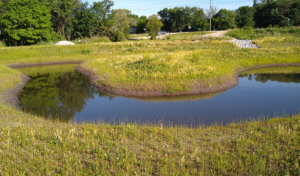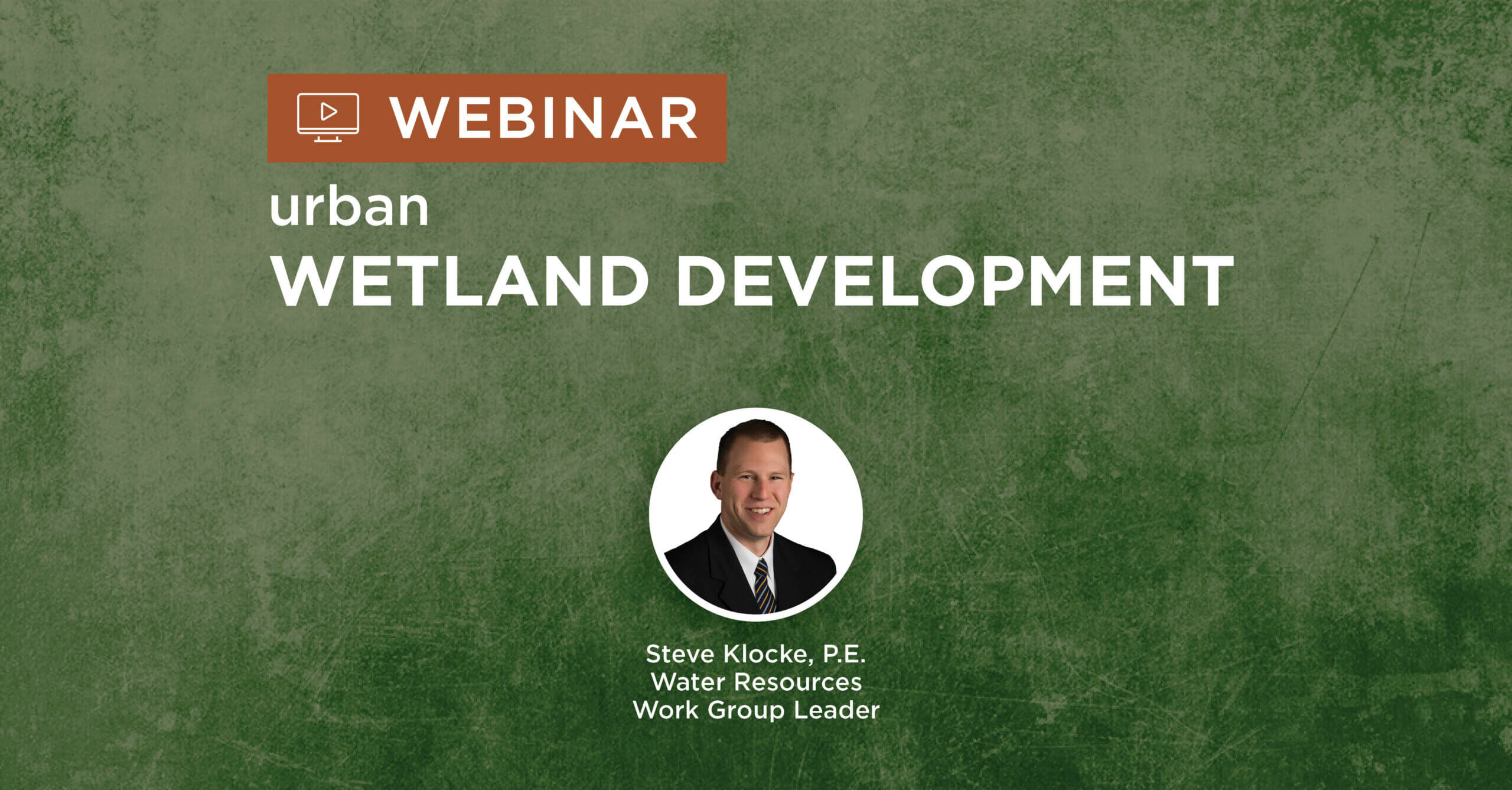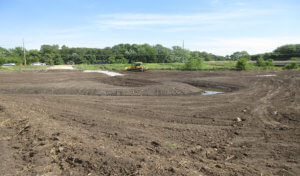Urban Wetland Protection and Restoration
Urban wetlands help fulfill an important function in improving surface water quality and purifying precipitation running off from towns and cities. As municipalities continue to expand and disrupt natural landscapes, learning how we can sufficiently use natural systems to try and mitigate the impending changes is in the best interest of city officials and citizens alike.
Listen as Steve Klocke, P.E., discusses some of our stormwater wetland projects and the benefits they deliver.
Webinar Agenda
- Urban Wetland Design (0:00)
- Fourmile Creek Stormwater Wetland Example (2:32)
- Practical Lessons Learned (8:27)

Steve Klocke, P.E.
Water Resources Work Group LeaderSteve Klocke, P.E.
Water Resources Work Group LeaderStormwater Analysis and Planning, Stream Assessment, Erosion and Sediment Control, Roadway Design, Project Plan and Contract Document.
Urban Wetland Design
Hi, I am Steve Klocke, and I am a civil engineer with Snyder & Associates in our Water Resources group. I want to talk today about urban stormwater management and how changing weather patterns are affecting our infrastructure systems, and how we can use natural systems to try and mitigate those changes. One of the components we would like to talk about today is a constructed stormwater wetland, and I would like to talk a little bit about urban stormwater management.
So, urban stormwater management, historically, the last three or four decades focused primarily on stormwater detention. Our goal was just to focus on those large storm events, the extreme flood, prevent flooding of downstream storm sewers, people’s homes, that kind of thing. Just focus on those large events with little consideration for what’s going on for the frequent and more common smaller events. That has been changing over the last few years. Now we’re talking about more of an integrated stormwater management approach. The focus here is on the unified sizing criteria, which is more of a holistic approach, looking at all storms. So, we still are providing that large storm detention to prevent flooding, but then also looking at treating or detaining or infiltrating the smaller frequent storms.
The goal here is really to mimic more of the undeveloped hydrology. So, if we’ve got a site that is currently undeveloped, and we’re looking at adding a residential or commercial development on it. We want the drainage coming off of that site to look as much like it does today as it will five years from now when it’s fully developed. So, there are several practices and BMPs, and approaches that we can utilize to make that happen. But one of them is constructed stormwater wetlands.
Constructed stormwater wetland is a comprehensive stormwater practice. As I mentioned, we’re looking to try and still control the large storm events to control those peaks, provide detention, and prevent downstream flooding, but then also provide small storm treatment and extended detention and retention with the goal of trying to remove sediment and remove nutrients from the runoff from those more frequent storms.
Fourmile Creek Stormwater Wetland Example (2:32)

Fourmile Creek stream meanders
One project we worked on recently was a constructed stormwater wetland for Fourmile Creek. This was a project we did for Polk County Conservation. The county received a water quality initiative grant that paid for most of the construction. The project’s located along Broadway Avenue and Fourmile Creek along the Gay Lee Wilson Trail.
So, one of the things that attracted the county to this location was the high visibility and that the public would be able to see what was being done by the county. Also, it was proposed in advance of the future widening of Broadway Avenue that’s going to occur at this location. So, trying to get that completed before the roadway widening is completed.
Stormwater Wetland Site Specifications
Just a quick location of where we’re at. As I mentioned, we’re along Broadway Avenue here in Des Moines or Polk County, and Fourmile Creek in the southwest corner of that intersection there. A few photos of the undeveloped site before we constructed the wetland. Just kind of a pasture area. This is a site that the county already owned. They had this property. There were some piles of broken concrete, and the site, I think, had previously been a little bit of a landfill for prior property owners. So, there was some debris on site but wasn’t used for anything at the time. Again, here’s just another photo showing the site itself in the foreground. In the background, what you can kind of see along the trail there on the far side of that trail, and right on the near side of the trail, two existing wetlands were constructed previously that were mitigation sites for other county projects. Those were things we had to stay away from.
The drainage area to the site was about 25 acres. It was a combination of a really large lot residential and then also the roadway. There was some impervious area but it wasn’t heavily developed. It certainly wasn’t a commercial area.
When we were looking at the site, the design criteria that we were using was focused primarily on what’s in the Iowa Storm Water Management Manual for stormwater wetlands. So, we’re looking at things like trying to provide a treatment forebay to gather sediment before it gets into the wetland. We’re looking at the storage volume so we can provide that detention for the larger storms. We’re looking to treat the water quality volume and the channel protection volume, providing that extended detention of the smaller storms to remove sediment, remove nutrients, and also prevent downstream channel erosion.
With that, we want a combination of a marshy area and some deep pools to mimic that predeveloped hydrology. With it being right along the creek, maybe it was previously a wetland so we want to return it to that type of function.
Also, flow length is a key component. We want to have a long enough flow path through the wetland that we are getting some removal of those nutrients and sediments. All those things get thrown into the design and the layout of this wetland.
Fourmile Site Constraints
We did have some constraints on the site. There were some challenges for sure. The site was somewhat small for the drainage area that we had. We were bounded on the east and the west by the property limit. So, the county only owned up to the driveway coming along there on the left side. So that was the limit there. On the right side, on the east side, there was the trail. We couldn’t get into that. To the north, at the top, we’ve got Broadway Avenue. And to the south, we’ve got those wetlands I’d mentioned before. We also had a sanitary sewer coming through along the north side we had to stay clear of the existing manhole, so we weren’t impacting that. And then, we had a FEMA floodway that clipped the corner of our site as well so, we had to be careful with what we developed within that FEMA floodway. The whole thing was in the FEMA floodplain. This is all in the fringe except for that corner that you see did end up in the floodway so we had to be careful with what we did there so we didn’t have impacts with the floodplain and a possible rise in the base flood elevation.
After a few iterations, keeping all those design criteria and these constraints in mind, this is essentially what we ended up with. At the top left corner, we’ve got our forebay that provides that temporary detention for incoming flow to try and remove some of the sediment before it gets into the wetland. And then you can see it overflows the rock flume or shoot down into the wetland, and then the flow snakes back and forth to get our long enough flow path through the wetland. At the top right, we’ve got an outlet structure and an overflow. It’s kind of a combination. There was an overflow structure for the larger storms to allow the water to pass through the larger storms. We also have a smaller inlet structure that releases kind of a trickle of water to draw down that water quality volume and the channel protection volume at a more controlled and slower release rate.
Here’s just another overlay of what we ended up with for our design laid on top of the aerial, so you can see how everything kind of fits together on the site. Then after construction, here’s what it is like today.
And then really just finishing up here with a few photos of the site. This is looking to the south from Broadway. So, on the right side, you’ll see our inlet and our forebay sitting up a little higher. And again, that dumps over into the wetland where you can kind of see it snaking around.
Another view here, we did seed everything with the native seed mix. These photos were taken just a year after the initial installation, so we haven’t had a ton of time when these photos were taken between the actual construction and the photos of those native plants getting established. They’re coming in pretty well. I think for the time that they were taken. It looks like it’s going to end up being nice. Again, you can see some of those natives here. Another year or two of the growth, and you’re probably going to see a lot more of the flowers coming through and a lot more color within the wetland.
Practical Lessons Learned (8:27)
These are just a few lessons from this project and some of the others we’ve completed.
Site Selection
One of the main things is site selection. We do want a site that’s going to be near a stream but not too close. That comes into play, especially with the stream that you have a floodplain along. We don’t want to have floodplain impacts where we’re in the floodway. Again, this one was a little bit, but we were able to control what we did there, so we didn’t have permitting issues.
Elevation
You do want to have some elevation across the site. You don’t want to completely flat site. You want to have some elevation so that you can get your forebay in that sits a little higher than the actual wetland. You want to be able to have and construct those marshy areas. And then have enough elevation that you can have some detention. It might involve building a little bit of a berm around there.
Adequate Spacing
Make sure you have adequate space. We were somewhat constrained on this site. Generally, as a rule of thumb, I would say you want five to 10% of the watershed area to be your stormwater wetland.
One thing that’s going to drive that is really how much impervious area you have within the watershed. Here we had a fairly low amount of impervious, this was mostly a large lot residential, so we didn’t need as large of a site. But if you had a lot of commercial area within the watershed, you’re probably going to be closer to that 10% for an area that you’re going to need to meet all the design criteria.
Consideration of Inlet Numbers
Keep in mind if you’ve got multiple inlets in this situation, we only had one location where we had water coming into the wetland. But if you had multiple inlets, you’re going to need multiple forebays, and you’re going to need to consider how all those multiple inlets come together for flow path and that kind of thing for treatment.
Available Access for Maintenance
Another important thing is to consider access for maintenance. You know, we’ve got a forebay in here. That eventually is going to need to be cleaned out. And that’s the purpose of it. It’s to gather and collect sediment. So once it starts to fill in, it is going to require someone to come in and dig that out and restore its volume.
Also, during establishment might need to be able to come in and do a little bit of weed control. Granted, that can be people coming in more on foot to do that work. You would want to consider how access for maintenance is going to play into it.
So, this was an exciting project that we had. I’m glad we did it. It was a challenge, like I said, with the area we had available and the large area we had draining to it, but we did keep working through it and eventually got it to work out, and it ended up being a pretty good-looking stormwater wetland.
If this is something you’re interested in, if a stormwater wetland looks like a possibility for you or your site, please feel free to contact us because we’d love to talk to you about it and see if we can help you out with that. Thank you very much.

